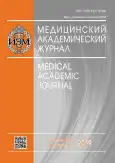ОСОБЕННОСТИ ФУНКЦИОНИРОВАНИЯ ИММУННОЙ СИСТЕМЫ В УСЛОВИЯХ СТРЕССОВЫХ НАГРУЗОК
- Авторы: Зайцева НС1, Сизякина ЛП1
-
Учреждения:
- ФГБОУ ВО «Ростовский государственный медицинский университет» Минздрава России
- Выпуск: Том 19, № 1S (2019)
- Страницы: 123-124
- Раздел: Статьи
- Статья опубликована: 15.12.2019
- URL: https://journals.eco-vector.com/MAJ/article/view/19359
- ID: 19359
Цитировать
Полный текст
Аннотация
Психобиологическая сущность стресса заключается в перепрограммировании ресурсов человеческого организма на выживание в экстремальных жизнеопасных условиях. Изучение активности основных гомеостатических систем в условиях острых и пролонгированных адаптационных реакций у военнослужащих представляет большой научно-практический интерес. Оценка иммунного статуса проводилась у 42 военнослужащих-офицеров, впервые участвовавших в спецоперациях. Выявлены не только количественные, но и структурные изменения функции иммунной системы у военнослужащих-участников спецопераций. Полученные результаты требуют дальнейшего анализа, изучения и учета в оценке состояния здоровья военнослужащих.
Ключевые слова
Полный текст
Об авторах
Н С Зайцева
ФГБОУ ВО «Ростовский государственный медицинский университет» Минздрава России
Л П Сизякина
ФГБОУ ВО «Ростовский государственный медицинский университет» Минздрава России
Список литературы
- Zaitseva NS, Sizyakina LP. Dysfunction of the immune system in the structure of comorbid pathology in military veterans of military operations in the remote period of observation. Immunology. 2016;37(5):267-270.
- Firdaus S. Enhancing versus Suppressive Effects of Stress on Immune Function: Implications for Immunoprotection and Immunopathology. Neuroimmunomodulation. 2009;16(5):300-317.
- Verburg-van Kemenade BM, Cohen N, Chadzinska M. Neuroendocrine-immune interaction: Evolutionarily conserved mechanisms that maintain allostasis in an ever-changing environment. Dev. Comp. Immunol. 2017;66:2-23.
Дополнительные файлы







